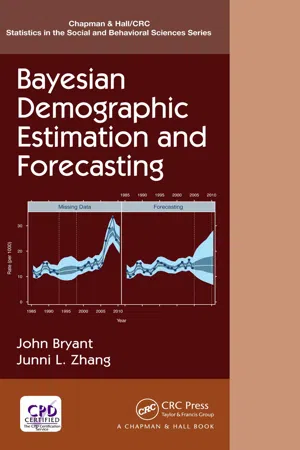![]()
Contents
Preface
1 Introduction
1.1 Example: Mortality Rates for Maori
1.2 Our Approach to Demographic Estimation and Forecasting
1.3 Outline of the Rest of the Book
1.4 References and Further Reading
PART I Demographic Foundations
2 Demographic Foundations
2.1 References and Further Reading
3 Demographic Individuals
3.1 Attributes
3.2 Events
3.3 Lexis Diagram
3.4 Twelve Fictitious Individuals
3.5 References and Further Reading
4 Demographic Arrays
4.1 Population Counts
4.2 Death Counts
4.3 Movements
4.4 Alternative Representations of Changing Statuses
4.5 Non-Demographic Events
4.6 Exposure
4.7 Age, Period, and Cohort
4.8 Rates, Proportions, Means, and Ratios
4.9 Super-Population and Finite-Population Quantities
4.10 Collapsing Dimensions
4.11 References and Further Reading
5 Demographic Accounts
5.1 Demographic Systems
5.2 Demographic Accounts
5.3 Account with No Region and No Age
5.4 Account with Region and No Age
5.5 Account with Age and No Region
5.6 Movements Accounts and Transitions Accounts*
5.7 Mathematical Description of Accounting Identities*
5.8 References and Further Reading
6 Demographic Data
6.1 Traditional Data Sources
6.2 New Data Sources
6.3 Data Quality and Model Choice
6.4 References and Further Reading
PART II Bayesian Foundations
7 Bayesian Foundations
7.1 Bayesian Statistics
7.2 Features of a Bayesian Data Analysis
7.3 References and Further Reading
8 Bayesian Model Specification
8.1 Using Probability Distributions to Quantify Uncertainty
8.2 Posterior as a Compromise between Likelihood and Prior
8.3 Standard Probability Distributions
8.3.1 Poisson Distribution
8.3.2 Binomial Distribution
8.3.3 Normal Distribution
8.3.4 Half-t Distribution
8.4 Exchangeability
8.5 Partial Exchangeability
8.5.1 Exchangeability within Groups
8.5.2 Exchangeable Residuals
8.5.3 Exchangeable Increments
8.6 Pooling Information
8.7 Hierarchy
8.8 Incorporating External Information
8.8.1 Priors
8.8.2 Covariates
8.8.3 Embedding the Model in a Larger Model
8.9 References and Further Reading
9 Bayesian Inference and Model Checking
9.1 Computation
9.2 Summarizing the Posterior Distribution
9.2.1 Summary Measures
9.2.2 Calculating Posterior Summaries
9.3 Derived Distributions
9.3.1 Posterior Distribution for Derived Quantities
9.3.2 Posterior Predictive Distribution
9.4 Missing Data
9.5 Forecasting
9.6 Model Checking
9.6.1 Responsible Modelers Check and Revise their Models
9.6.2 Heldback Data
9.6.3 Replicate Data
9.7 Simulation and Calibration*
9.8 References and Further Reading
PART III Inferring Demographic Arrays from Reliable Data
10 Inferring Demographic Arrays from Reliable Data
10.1 Summary of the Framework of Part
10.2 Applications
10.3 References and Further Reading
11 Infant Mortality in Sweden
11.1 Infant Mortality Rate
11.2 Infant Mortality Rates in Swedish Counties
11.3 Model
11.3.1 Likelihood
11.3.2 Model for Underlying Infant Mortality Rates
11.3.3 Prior for Region Effect
11.3.4 Prior for Time Effect
11.3.5 Prior for Intercept
11.3.6 Prior for Standard Deviation
11.3.7 Summary
11.4 Results
11.4.1 Infant Mortality Rates
11.4.2 Intercept, Region Effects, and Time Effects
11.4.3 Prior for Time Effect
11.4.4 Standard Deviations
11.5 Model Checking
11.5.1 Model Predictions versus Direct Estimates
11.5.2 Regional Variation in Slopes
11.6 Summarizing Results via Probabilities
11.7 Forecasting
11.7.1 Constructing the Forecasts
11.7.2 Results: Exploding Credible Intervals for Forecasting
11.7.3 A Partial Solution
11.8 References and Further Reading
12 Life Expectancy in Portugal
12.1 Mortality Rates
12.2 Log Function
12.3 Life Expectancy
12.4 Age, Sex, and Time Effects
12.5 Interactions
12.6 Models
12.6.1 Likelihood
12.6.2 Model for Mortality Rates
12.6.3 Prior for Age Effect
12.6.4 Prior for Time Effect
12.6.5 Prior for Age-Time Interaction
12.6.6 Prior for Sex-Time Interaction
12.6.7 Priors for Other Terms
12.6.8 Summary
12.7 Model Choice Using Heldback Data
12.8 Estimating and Forecasting
12.9 Comparing the Forecasts with the Heldback Data
12.10 Results
12.11 Forecasting of Life Expectancy for 2016-2035
12.12 Obtaining Forecasts of Life Expectancy*
12.13 References and Further Reading
13 Health Expenditure in the Netherlands
13.1 A Simple Expenditure Projection
13.2 Expenditure Projections for the Netherlands
13.3 A Statistical Model for Per Capita Expenditures
13.4 Model Checking via Replicate Data
13.5 Revised Expenditure Projections
13.6 Forecasting Policy Outcomes
13.7 References and Further Reading
PART IV Inferring Demographic Arrays from Unreliable Data
14 Inferring Demographic Arrays from Unreliable Data
14.1 Summary of the Framework
14.2 Data Models
14.3 Applications
14.4 References and Further Reading
15 Internal Migration in Iceland
15.1 Internal Migration in Iceland
15.2 Confidentialization by Random Rounding to Base Three
15.3 Overview of Model
15.4 System Model
15.5 Data Model
15.6 Estimation
15.7 Results for Unconfidentialized Migration Counts
15.8 Results for Migration Rates
15.9 Forecasting
15.10 References and Further Reading
16 Fertility in Cambodia
16.1 Data
16.2 Overview of Model
16.3 System Model
16.4 D...
